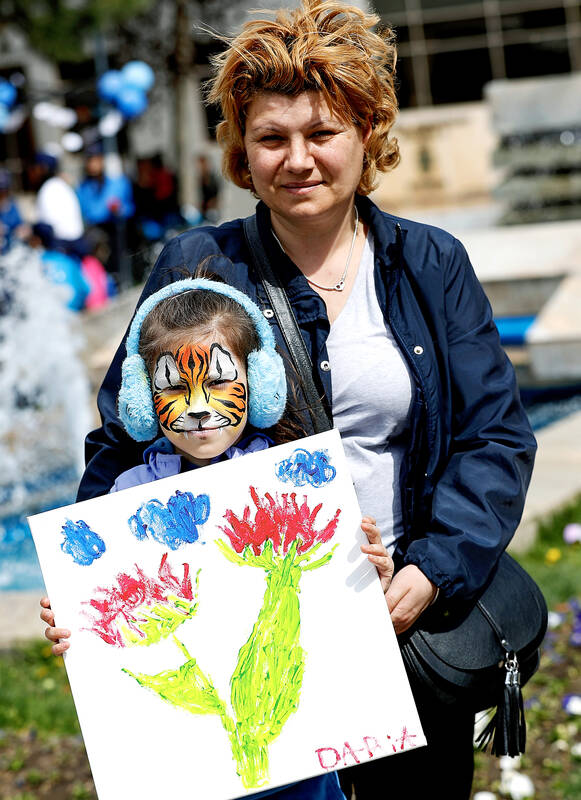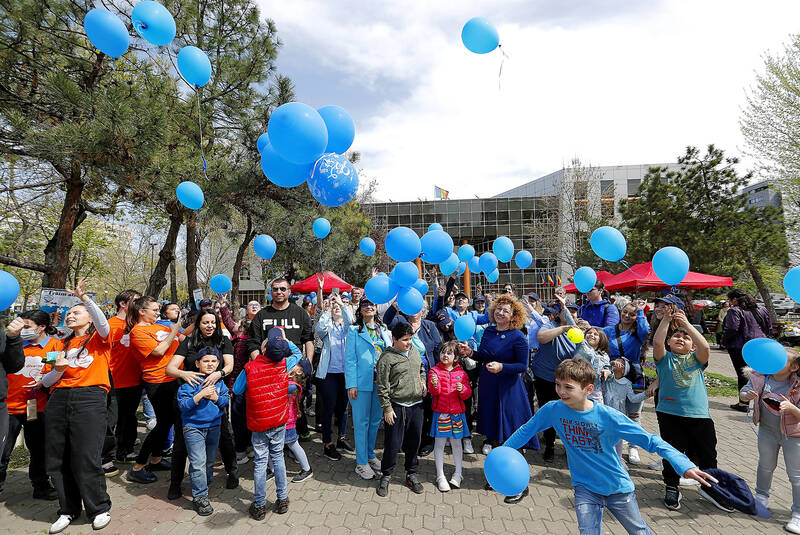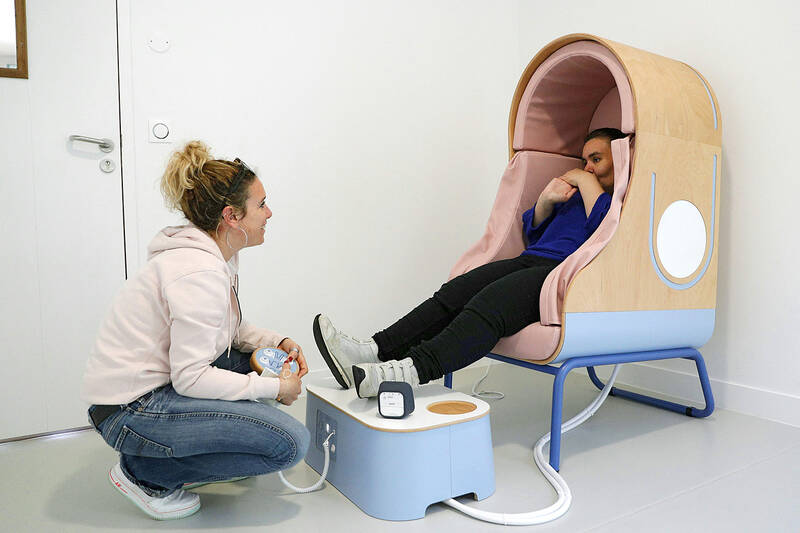Autism spectrum disorder (ASD) is a neurological and developmental condition marked by disruptions in brain-signaling that causes people to behave, communicate, interact and learn in atypical ways.
Autism diagnoses in the US have increased significantly since 2000, intensifying public concern over what might contribute to its prevalence. Here is what you need to know.
HOW IS AUTISM DIAGNOSED?

Photo: EPA-EFE 照片:歐新社
There are no objective tools for diagnosing autism, such as blood tests or brain scans. Instead, diagnoses are made based on observations and interviews.
The term “spectrum” reflects the wide range of possible manifestations. Some people with ASD might have good conversation skills, while others might be nonverbal. Some might be acutely sensitive to sounds, touch or other triggers. Some might have restricted or repetitive behaviors or interests. Some might need help with daily living, while others require little or no support.
The American Academy of Pediatrics recommends screening all children at 18 and 24 months old, when most children begin to show symptoms, yet the average age of diagnosis is close to four years old in the US and five years old globally.

Photo: EPA-EFE 照片:歐新社
HOW COMMON IS AUTISM?
By 2020, the US autism rate in eight-year-olds was 1 in 36, or 2.77 percent, up from 2.27 percent in 2018 and 0.66 percent in 2000, US Centers for Disease Control and Prevention data show. A 2021 study from England put the rate in children there at 1.76 percent, up from 1.57 percent in 2009.
The WHO estimates the worldwide prevalence in children at 1 percent, up from 0.62 percent in 2012, with the caveat that many countries lack the resources to identify and report cases.

Photo: AFP 照片:法新社
WHAT CAUSES AUTISM?
The causes of autism are unclear. There is widespread speculation among scientists that its neurological characteristics might develop in utero, when the fetal brain is being wired. Studies have linked autism to maternal factors in pregnancy, and some research suggests a link to birth complications and timing.
A growing area of research focuses on epigenetics — the interactions between genetic and environmental factors. One theory suggests that a woman’s exposure to air pollution or harmful contaminants before or during pregnancy might trigger a genetic mutation leading to autism in her child.
Gene variations in some people with autism strengthen the evidence for a genetic component. Among the genetic disorders linked with higher risks for autism are Fragile X syndrome, tuberous sclerosis complex, Phelan-McDermid syndrome and Prader-Willi syndrome.
Other potential factors might include havign a sibling with autism, the age of parents when conceiving children, very low birth weight, jaundice in infancy, complications in utero or during birth, having an unhealthy assortment of organisms living in the intestines and immune system disorders. US Health and Human Services Secretary Robert F Kennedy Jr and other public figures have promoted a theory — contrary to scientific evidence — that childhood vaccines are a cause of autism. The idea stems from a since-debunked study by British researcher Andrew Wakefield in the late 1990s that connected a rise in autism diagnoses with widespread use of the measles vaccine.
No rigorous studies have found links between autism and vaccines or medications or their components, such as thimerosal or formaldehyde.
WHY ARE AUTISM RATES RISING?
Researchers attribute the rise in autism diagnoses to more widespread screening and the inclusion of a wider range of behaviors to describe the condition.
In 2013, mental health experts combined what had been three separate diagnoses — autistic disorder, Asperger’s Syndrome and pervasive developmental disorder — under the umbrella of ASD. An October 2024 study of US insurance claims data found that the largest increases in diagnoses were in groups with historically low screening rates, including young adults, females and children from some racial or ethnic minority groups.
Researchers also noted that certain risk factors have become more common, such as being born prematurely or to older parents.
ARE THERE TREATMENTS?
There are no treatments or cures for autism, nor can it be reversed. However, experts agree that early diagnosis is crucial. Intervention with supportive measures — ideally before age three — is critical for improving cognitive, social and communication skills.
Such measures can include speech therapy, occupational therapy, social skills training, sensory integration therapy, visual aids, structured routines, individualized education plans, family therapy, and providing a calm and predictable environment.
(Reuters)
自閉症類群障礙(或譯「自閉譜系疾患」,簡稱自閉症,或縮寫為ASD)是一種神經和發育疾病,其特徵是腦訊號中斷,導致患者以非典型方式行為、溝通、互動和學習。
自2000年以來,美國的自閉症診斷數量顯著增加,讓民眾愈發擔憂是否有何因素導致自閉症流行。以下是您所需了解的事項:
自閉症如何診斷?
目前並無像血液檢查或腦部掃描之類的客觀工具可用來診斷自閉症。與此相反,自閉症的診斷是根據觀察和訪談做出的。
術語「譜系」反映了可能表現形式的廣泛範圍。有些自閉症患者可能有良好的談話技巧,有些則可能是不說話。有些人可能對聲音、觸摸或其他觸發因素極為敏感。有些人對一些行為或興趣有無法從事或重複去做的可能。有些人的日常生活可能需要幫助,而有些人則幾乎不需要或根本不需要協助。
美國兒科學會建議對所有兒童在18至24個月時進行自閉症篩檢,因為大多數患有自閉症的兒童,症狀會在此時開始出現。然而,美國的平均診斷年齡仍為近四歲,全球平均診斷年齡為五歲。
自閉症有多常見?
根據美國疾病管制與預防中心的數據,截至2020年,美國八歲兒童的自閉症發生率為1/36,即2.77%,高於2018年的2.27%和2000年的0.66%。英國2018年的一項研究顯示,該國兒童患有自閉症的比例從2009年的1.57%上升至1.76%。
世界衛生組織估計,全球兒童的自閉症發生率為1%,高於2012年的0.62%,但許多國家缺乏識別病例及通報病例的資源。
自閉症的成因為何?
自閉症的病因尚不明確。科學家普遍猜測,自閉症的神經特徵可能是在子宮內形成的,在胎兒的大腦形成期間。研究顯示自閉症與懷孕期間的母體因素有關,一些研究顯示它與分娩併發症和時間有關。
越來越多的研究集中在表觀遺傳學——遺傳因素和環境因素之間的相互作用。有一種理論認為,女性在懷孕前或懷孕期間接觸空氣污染或有害之污染物,可能會引發基因突變,導致孩子罹患自閉症。
部分自閉症患者的基因變異強化了遺傳因素的證據。與自閉症高風險相關的遺傳性疾病包括X染色體易裂症、結節性硬化症、費蘭-麥克德米德症候群,以及普拉德威利症候群〔俗稱小胖威利症〕。
其他潛在風險因素可能包括兄弟姊妹患有自閉症、受孕時父母之年齡、出生體重過低、新生兒黃疸、子宮內或分娩併發症、腸道內有不健康微生物,以及免疫系統失調。美國總統唐納‧川普所任命的美國衛生部長小羅伯特‧F‧甘迺迪及其他公眾人物提出了一個違背科學證據的理論,即兒童疫苗是自閉症的成因。此想法源自英國研究人員安德魯‧韋克菲爾德在1990年代末進行的一項後來被踢爆的假研究,該研究將自閉症診斷率的上升與麻疹疫苗的廣泛使用聯繫起來。
尚無嚴謹的研究發現自閉症與疫苗或藥物或其成分(如硫柳汞或甲醛)之間存在關聯。
自閉症罹患率為何上升?
研究人員將自閉症診斷率的上升歸因於更廣泛的篩檢,以及將更廣泛的行為納入此病症。
2013年,心理健康專家將三種不同的診斷——自閉症、亞斯伯格症和廣泛性發展障礙——合併為自閉症類群障礙。2024年10月對美國保險理賠資料的研究發現,診斷增幅最大的是過去篩檢率較低的族群,包括年輕人、女性和少數族裔的兒童。
研究人員也指出,某些風險因素已變得更加常見,例如早產或父母高齡生育。
自閉症有治療方法嗎?
自閉症無法治療或治癒,也無法逆轉。然而,專家一致認為早期診斷至關重要。以輔助措施介入——最好在三歲之前——對提高認知、社交及溝通能力極為重要。
這些輔助措施包括語言治療、職能治療、社會技能訓練、感覺統合治療、視覺輔助、結構化常規、個人化教育計畫、家庭治療,以及提供平靜可預測的環境。
(台北時報林俐凱編譯)

Even as he grows older, Microsoft founder Bill Gates still fondly remembers the catalytic computer code he wrote 50 years ago that opened up a new frontier in technology. Although the code that Gates printed out on a teletype machine may look crude compared to what’s powering today’s artificial intelligence platforms, it played a critical role in creating Microsoft in April 1975 — a golden anniversary that the Redmond, Washington, company celebrated on April 4. Gates, 69, set the stage for that jubilee with a blog post reminiscing on how he and his old high school friend — the late Paul Allen

Australia’s strict immigration policies have long been criticized, particularly for how they treat people with disabilities. Having been residents of Australia for years, Scottish Laura Currie and her Italian partner, Dante Vendittelli, recently experienced the impact of these immigration policies. Their son Luca, born in Australia and diagnosed with cystic fibrosis, became the reason their residency application was denied due to the anticipated high healthcare costs. Had Luca been healthy, there would have been no objections to their permanent residency. This case not only highlights discrimination against disabled individuals, but also raises questions about fairness and inclusion within Australia’s immigration

A: After holding nine concerts in Kaohsiung and Taipei recently, “God of Songs” Jacky Cheung will stage three extra shows later this week. B: They’re compensation for the three shows he postponed last year due to illness. A: He also canceled three more shows in Guangzhou last month. His health is worrisome. B: When touring Guangzhou, he dedicated his hit “She Is Far Away” to late singer Khalil Fong. That’s so touching. A: Online music platform KKBOX has also launched a campaign to pay tribute to Fong. I can’t believe he died so young: he was only 41. A:

A: After “God of Songs” Jacky Cheung sang for late singer Khalil Fong recently, music streaming service KKBOX also paid tribute to Fong by releasing his greatest hits online. B: The 20th KKBOX Music Awards ceremony is taking place at the K-Arena in Kaohsiung tomorrow. Fong performed at the ceremonies in the past. A: Who are the performers this year? B: The performers include Taiwanese groups 911, Wolf(s), Ozone, Singaporean pop diva Tanya Chua, and K-pop group Super Junior. A: South Korean stars actually took four spots among KKBOX’s 2024 Top 10 singles, showing that K-pop is still